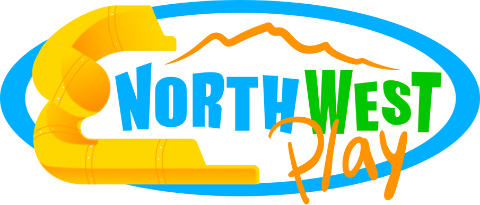When new party center and indoor play operators begin their search for a suitable facility, a thousand details climb to the surface: location, HVAC, ingress/egress, fire codes, restrooms, parking, and so on. But one of the most critical—and often underappreciated—decisions has nothing to do with theming or furniture or flooring. It’s ceiling height.
In this post, I’ll explore both the advantages and downsides of different ceiling height regimes for indoor playgrounds, and offer practical guidance for balancing ambition, costs, and operational realities.
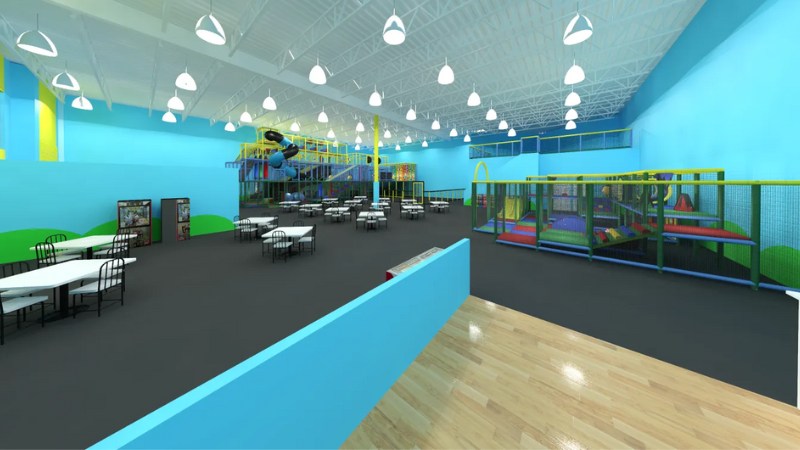
Why Ceiling Height Is a Core Constraint
When you imagine a “kid play structure,” you probably picture multi-level climbing frames, slides, tunnels, bridges, and perches. Almost every design of an indoor playground structure presumes a certain vertical envelope—if your ceiling is too low, many features become impossible or unreasonably constrained.
Put simply: ceiling height limits how tall your play structure can grow, which in turn influences:
The asset value and “wow factor” of your play offering.
The appeal to older kids (and thus retention).
How much floor space you’ll need for a given play volume.
Sightlines, parental comfort, ease of ingress and egress, and ease of supervision.
Infrastructure challenges (sprinklers, mechanical systems, acoustics).
So let’s run through a few typical height scenarios, their trade-offs, and how to decide what “good enough” means for your particular project.
Ceiling Height - Scenario 1
Below ~15′ (4.6–4.8 m)
Ceilings below 15′ typically determine a maximum height of (2) levels, which as we will discuss later, can be detrimental to retention and the long term return on investment.
Limitations:
- A ceiling under 15′ (especially in the 12–14′ zone) typically does not allow for a safe, meaningful third tier.
- That means your structure is capped at two levels, which for today’s preteen kids can feel flat and underwhelming.
- For older kids, rapid loss of novelty. An 8-year-old will run through a two-level structure pretty quickly, leading to a stale layout over a few visits.
- Shrinking demographic appeal. You may limit your play appeal to children age ~6–7 and under, narrowing your target market.
- If that is your business plan, under 6 years – a two level structure may suffice.
- Greater footprint, less density. To deliver exciting variety with only two levels, you may have to spread horizontally.
- Horizontal spread requires more floor space, which may raises lease and build-out costs.
- Moreover, as your play area grows outward, you run into challenges of ingress/egress and supervision.
- Lower visual impact & “ceiling creep.”
Low ceilings can feel claustrophobic, hamper vertical lines of sight, and reduce the perceived scale and ambience of your center.
When a lower ceiling can still work:
You have a very large single-floor playground (say, >1,500 ft²) and enough horizontal spread to absorb the lack of height.
Your business model appeals strictly to children under 6 years old.
Your activity mix emphasizes other attractions (laser tag, VR, inflatables) over vertical play.
You include other ‘Activity Play’ elements or interactive 2-level ball shooters (Ballocity).
You target, ans accept a more limited age range (business plan).
Typically, the trade is that you must invest heavily in the breadth of offerings—more modules, more themes, more zones—to compensate for the height deficit.
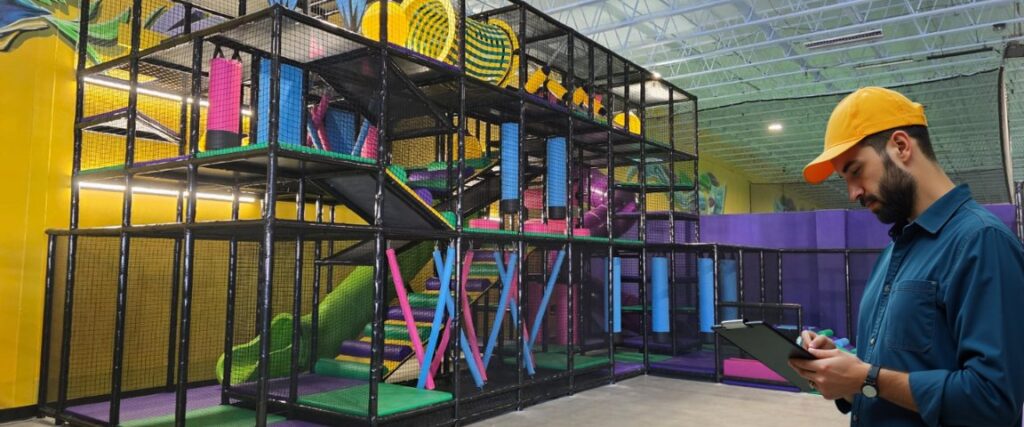
Ceiling Height - Scenario 2
15′6″ to ~20′ (4.7 m to ~6.1 m)
This is often the entry-level “sweet spot” in many play-center projects.
This is really the minimum vertical envelope that permits a 3-level play structure. At 15′6″ (≈4.72 m) you have the minimum clearance required for a structure based on a 7′ first level, 4′ second and third levels, with enough room for safety post padding.
Scenario 2: Advantages:
1. Three-level play becomes viable. You now unlock more vertical density and excitement without entirely overhauling every detail of your build.
2. Balance vertical vs. horizontal. You can increase play density (more height) without pushing out horizontally as much, leaving more remaining floor for revenue zones (arcade, birthday rooms, other activities, seating).
3. Better age diversity. The third level gives appeal to 8–10 year olds who still crave vertical challenge. It gives more room for progression—kids can graduate through the levels gradually.
Drawbacks or constraints:
- The headroom on the topmost tier may still be limited, which constrains some elements (slide drop distance, tunnel height, vertical clearance).
- Some “wow” features such as full-height speed slides or multi-story spirals may become difficult to fit, depending on overall size.
- You may find yourself bumping against ceilings when trying to route ducting, sprinklers, cable trays, or lighting.
So you can do nicely in this scenario—especially as you push beyond 16-18 feet, but you must be deliberate about which signature features you include and how you design vertical clearances.
Ceiling Height - Scenario 3
~20′ to ~24′ (6.2 m to ~7.3 m)
Once you cross 20′ (roughly), the playground world opens up. Ideally, for larger, community-centric facilities catering to kids infant to 10-12 years, this is the best scenario for the long term prospects of the business, including competitive barrier to entry.
Scenario 3 : Advantages:
1. You can deliver robust multi-level experiences with tall tunnels, more vertical freedom, and more “air” between levels. Creating a full, fun structure of three to five levels of “volume” .
2. This space can now accommodate a variety of internal (play-a-bility) climbs, crawls and slides that keep kids in constant movement, across multiple levels and activities. Iconic vertical features become feasible.
- Full-length speed slides from the top all the way down.
- Tall spiral slides with dramatic profiles.
- Multi-level interior slides or tunnels.
- Suspension bridges with perceived danger.
- Zip lines, rope bridges, net climbs, bungee towers.
3. Better appeal and retention for older kids. These high-flying features provide challenge and brag factor—kids want to return to “that crazy Big Black slide.”
4. More compact footprint. Because you can build up, you don’t need to spread out as far laterally. That frees up floor area for other offerings: redemption games, VR zones, party rooms, café, lounge, stroller zones, etc.
5. Superior sightlines and openness. Tall structures allow for more open vertical volumes, meaning better parent access and visibility, better airflow, and more “wow” when you walk in.
6. Flexibility for future expansion. If your initial layout underutilizes full height (for cost reasons), you still have headroom to upgrade or add hybrid attractions later. Our ‘Ramp-to-Completion’ offers developers an upgrade strategy over time as income and demand grows, so too can your play structure.
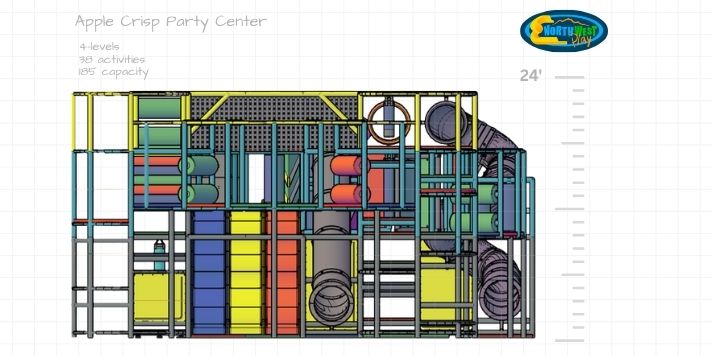
Potential challenges / costs:
Depending on design, over four levels may require structural support, including steel framing, heavier-duty anchoring, and more rigorous engineering as applies to ASTM and other safety guidelines.
High ceilings create large sound volumes; sound can bounce and echo, raising ambient noise pressure. Without mitigation, the parent zone or seating areas may feel unpleasant.
In our experience designing indoor play spaces, 22′ to 24′ is considered a long-term luxury: tall enough to be dramatic, yet still manageable, with room for growth and a huge WOW factor. If you can push beyond (say 28′ or into clear-span industrial warehouse heights), that becomes even more compelling—but you also enter into some greater complexity.
Matching Your Height Decision to Your Business Strategy
One of the biggest mistakes new operators can make is blindly chasing “as tall as possible” without weighing trade-offs.
Working with Northwest Play means you can pull from our many years experience across all kinds of traditional, active and interactive play designs and target age groups to best determine design/layout vs. cost/revenues.
The optimal height for your indoor play structure design should be based on;
1. Target age segments. If your focus is preschoolers or toddlers, 15–16′ is adequate. If you want to compete for 8–12 year old’s, you’ll want higher.
2. Play-density goals / throughput targets. You’ll want to maximize volume per square foot if your land/lease cost is high.
3. Ancillary offerings. Video arcade, redemption, VR, party rooms, café—all need some floor allocation; you don’t want your playground to monopolize square footage inefficiently.
4. Lease or build cost sensitivity . As mentioned above, lease space with taller ceilings may cost more than lower ceiling space, however the trade-off of lateral space, visibility, access and supervision can be a negative. A conversation to consider with your overall business goals.
5. Phasing and scalability also plays a key role. If you might expand later (mechanically or in play), preserving headroom gives you more flexibility.
The Psychology of Vertical Challenge
Psychological dimension: Why vertical matters
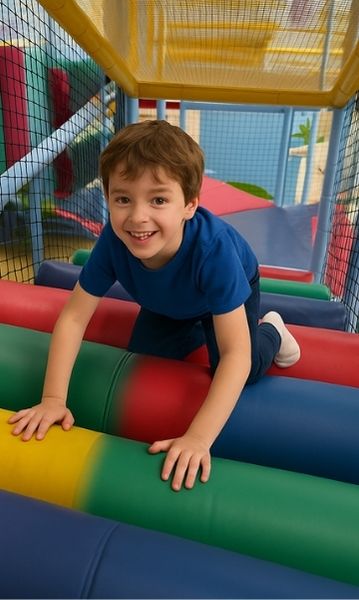
Children’s desire to climb, explore, and conquer height is deeply ingrained. As kids grow, their fear threshold changes: younger children (under 5) are usually cautious and sensitive to heights; they observe older kids further above and may hesitate to climb up or engage. As they gain confidence, they want to go higher.
By providing progressive vertical zones—lower steps or platforms leading gradually upward—you can shepherd timid climbers into bravery. A bold speed slide from the very top becomes an aspirational goal: “One day, that’s me.”
Even if a child doesn’t ride the top slide initially, the very visibility of it invites ambition. If your ceilings are low, that pathway of progression closes early. The 6–8-year-old may see no further challenge and move on.
But with tall structures, you maintain an aspirational gradient—kids can always push to “just one more level,” fueling repeat visits and word-of-mouth.
- Further, tall levels allow openness and visibility:
- Parents appreciate seeing their children across vertical levels.
- Staff can monitor zones more effectively with vantage points.
- It feels more “airborne” and less claustrophobic.
- Even when assisting a distressed child or playing with them, a height buffer keeps the parent more comfortable (you won’t always be kneeling or crouching in tight tunnels).
- From a branding and guest-perceived quality standpoint, height communicates ambition, scale, and premium experience. “Big” feels exciting.
Acoustic Reality: Don’t Let the Roar Ruin the Vibe
One of the biggest pitfalls of high-ceiling play centers is noise—particularly echo, reverberation, and crowd volume. Parents sometimes enter and think: “This is too loud. I can’t stay long.”
High ceilings exacerbate sound issues because:
- There is more air volume for sound waves to travel and reflect.
- Voices and impacts travel farther before dissipating.
- Hard, reflective surfaces (metal deck, exposed concrete, ducts) amplify reverberation.
So if you go tall, you must plan for acoustics from the start. Northwest Play has experience with nosie abatment and acoustical design, helping to mitigate any potential issues. Here are a few basic acoustic strategies & data-backed tips:
1. Absorption > Blocking (inside the space). Use acoustical panels, felt or PET “clouds” or “cloud-panels,” wall baffles, and ceiling clouds to absorb sound waves and reduce echo.
2. Strategic placement of absorption at height. Panels suspended between joists, hanging “clouds,” or vertical banners drop into the listening zone to intersect sound paths.
3. Mixed materials on vertical surfaces. Acoustic wall panels, fabric-wrapped surfaces, padded buffers, perforated wood slats, or carpeting on back walls help diffuse and absorb reflections.
4. Balance absorption and openness. Don’t drape the whole ceiling in absorptive panels; you still want vertical openness and daylight. Use patterns and clustering to break up long parallel surfaces.
5. Remember staff zones and back-of-house acoustics. Don’t overlook the impact noise in staging rooms, mechanical rooms, party prep areas, or corridors adjacent to the play volume.
In summary: When considering taller ceilings keep in mind the possible need for sound control. Don’t treat it as an afterthought.
Practical Tips for Working with Height Constraints
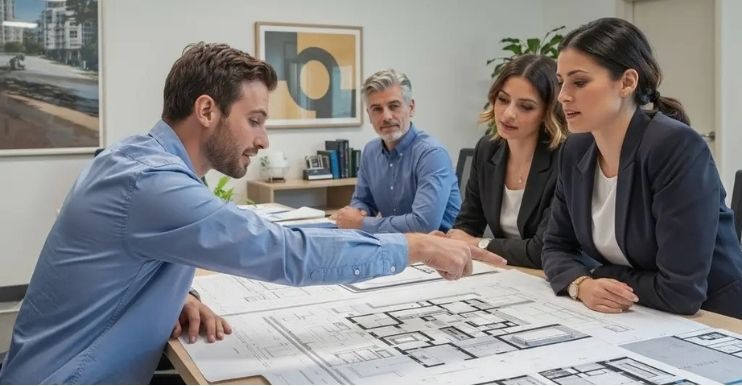
When negotiating or designing a space, consider these pointers:
1. Ask for “clear height” not just “ceiling height.” That means the vertical distance between finished floor and the underside of roof/structure clearance (not including dropped ceilings, beams, or light fixtures).
2. Account for required clearance above play levels. The top of your slide launch or net should have “breathing room” to the structural roof—not just a few inches.
3. Check mechanical, sprinkler, and lighting limitations early. Some fire codes require minimum clearance to sprinkler heads or require particular spacing that could limit your usable vertical envelope.
4. Plan for future upgrade paths. If you can build floor strength and structural supports ahead, you may later add additional levels or suspended play structure.
5. Negotiate flexible lease terms. If height is a major strategic differentiator, consider rent tiers or build allowances for ceiling enhancements.
6. Segment by height zones. If your ceiling is partly lower (due to duct runs or soffits), consider dividing zones: lower-ceiling toddler or soft-play zones, and higher-ceiling main arena.
7. Use mixed-height modules. Even in a tall space, you don’t always need everything at full height—give kids varied vertical gradients to facilitate progression.
8. Anchor vertical growth to marketing. Use your high slides, transparent levels, and visibility as selling points in marketing and tours.
Conclusion: Height as Strategy, Not Just Specification
Ceiling height for an indoor playground is far more than a technical constraint. It’s part of your play strategy, your market positioning, and your operational flexibility.
- Low ceilings (below ~15′6″) restrict you to two-level designs and force more horizontal spread.
- Midrange (~15′6″ to ~20′) unlocks three-level play, balanced growth, and wider appeal.
- Higher ceilings (~20′–24′ and up) let you deliver dramatic vertical experiences, compress footprints, and maintain novelty for older kids.
- Importantly: acoustics must be baked in, especially in tall volumes.
Noise control is not optional if you want parents to linger, relax, and feel comfortable. For operators, the ideal height is the maximum that your budget, lease, market, and business plan support—while still giving you room to surprise, innovate, and grow.
If you are in that process and thinking about your space, give Northwest Play a call for a no-obligation analysis of your project goals, space planning and play design – we’re here with 30 plus years, ready to help.
Thanks for reading and be sure to bookmark our Playground blog for more great articles, tips and ideas.
